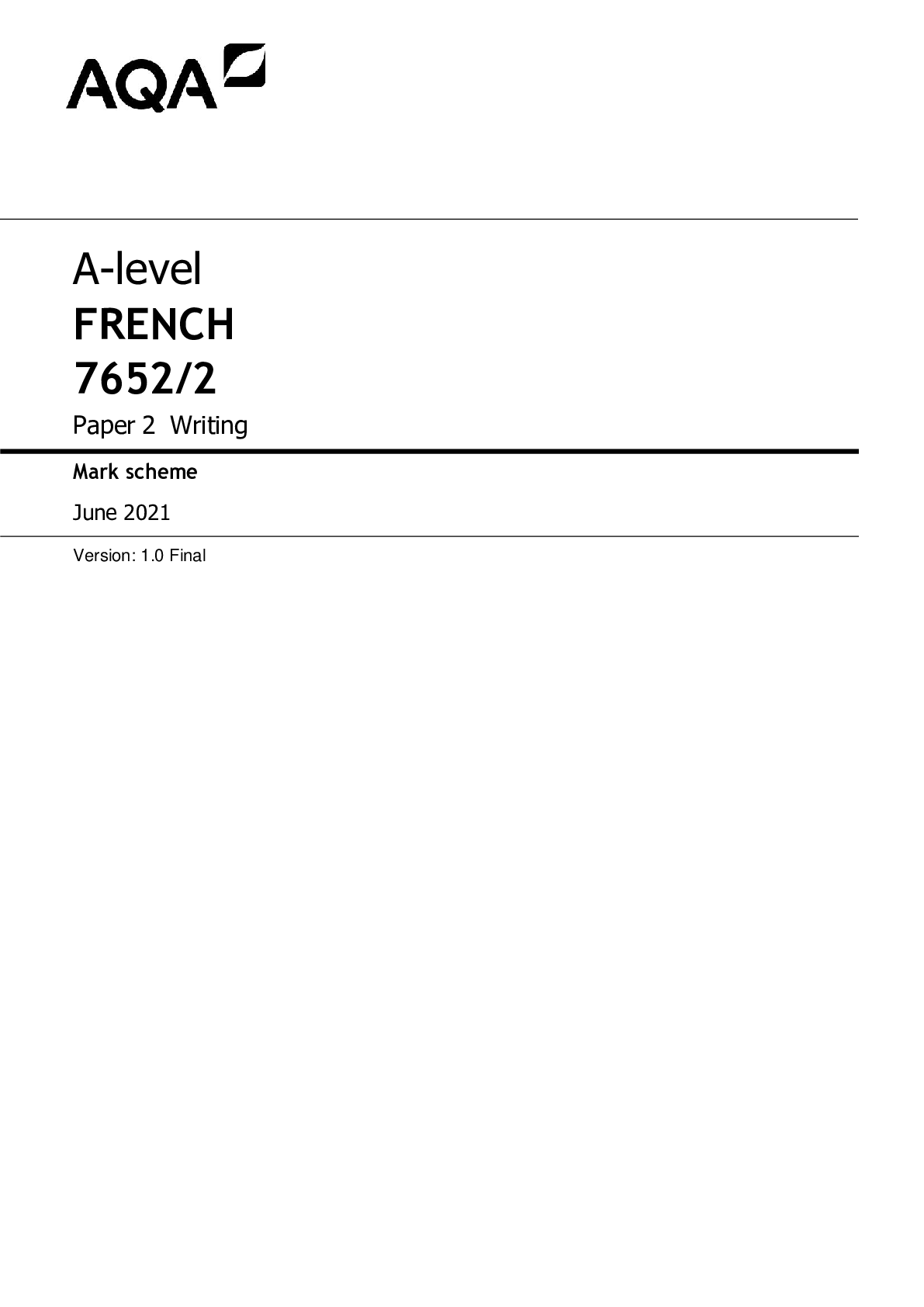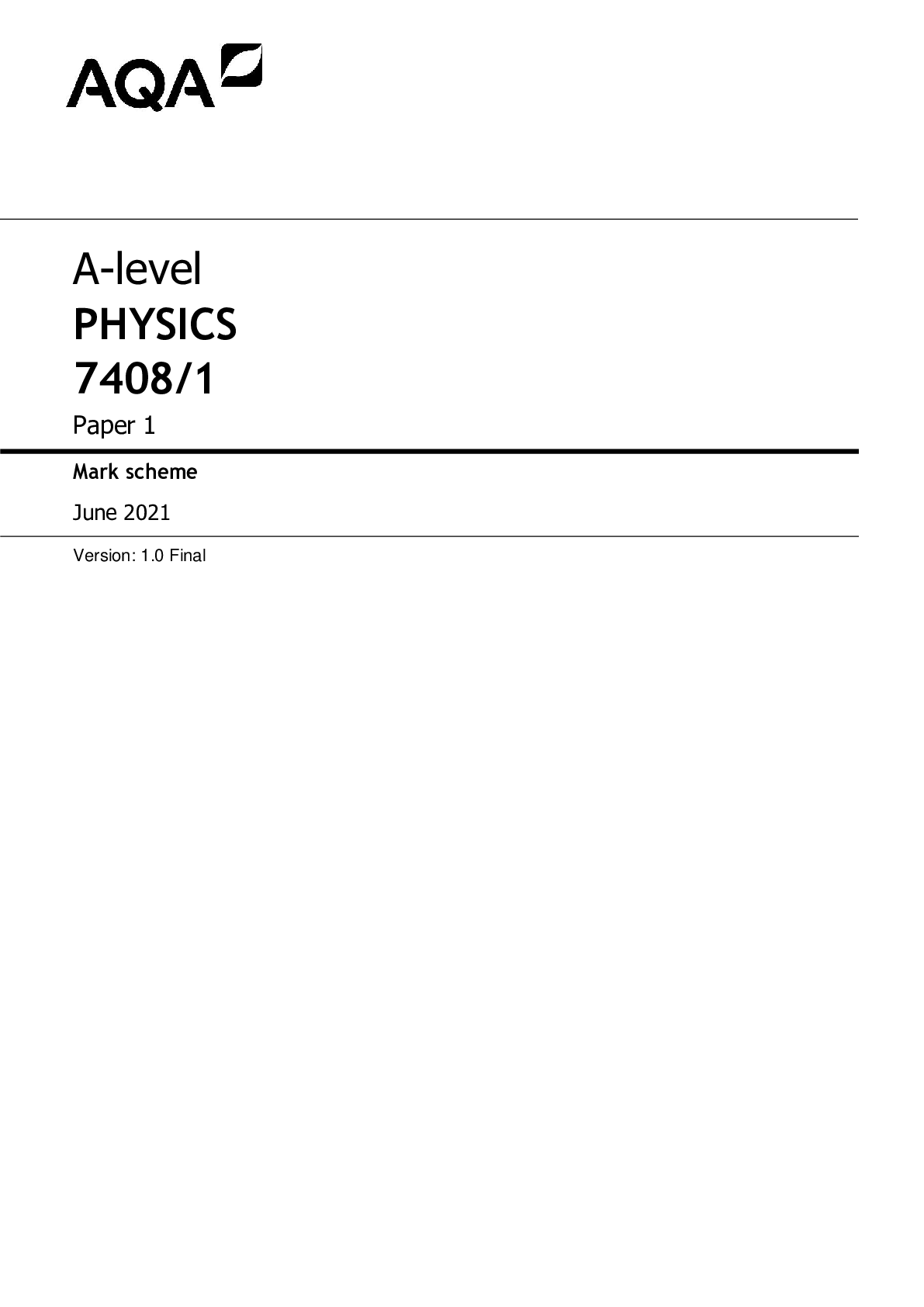Chemistry > A-Level Mark Scheme > AQA AS Level Chemistry 7404-1 Paper 1 Inorganic and Physical Chemistry Mark Scheme June 2021 (All)
AQA AS Level Chemistry 7404-1 Paper 1 Inorganic and Physical Chemistry Mark Scheme June 2021
Document Content and Description Below
AQA AS Level Chemistry 7404/1 Paper 1 Inorganic and Physical Chemistry Mark Scheme June 2021 / AQA AS Level Chemistry 7404-1 Paper 1 Inorganic and Physical Chemistry Mark Scheme June 2021 / AQA AS Lev... el Chemistry Paper 1 Inorganic and Physical Chemistry Mark Scheme June 2021 AS CHEMISTRY 7404/1 Paper 1 Inorganic and Physical Chemistry Mark scheme June 2021 Version: 1.0 Final *216A7404/1/MS* MARK SCHEME – AS CHEMISTRY – 7404/1 – JUNE 2021 2 Mark schemes are prepared by the Lead Assessment Writer and considered, together with the relevant questions, by a panel of subject teachers. This mark scheme includes any amendments made at the standardisation events which all associates participate in and is the scheme which was used by them in this examination. The standardisation process ensures that the mark scheme covers the students’ responses to questions and that every associate understands and applies it in the same correct way. As preparation for standardisation each associate analyses a number of students’ scripts. Alternative answers not already covered by the mark scheme are discussed and legislated for. If, after the standardisation process, associates encounter unusual answers which have not been raised they are required to refer these to the Lead Examiner. It must be stressed that a mark scheme is a working document, in many cases further developed and expanded on the basis of students’ reactions to a particular paper. Assumptions about future mark schemes on the basis of one year’s document should be avoided; whilst the guiding principles of assessment remain constant, details will change, depending on the content of a particular examination paper. Further copies of this mark scheme are available from aqa.org.uk Copyright information AQA retains the copyright on all its publications. However, registered schools/colleges for AQA are permitted to copy material from this booklet for their own internal use, with the following important exception: AQA cannot give permission to schools/colleges to photocopy any material that is acknowledged to a third party even for internal use within the centre. Copyright © 2021 AQA and its licensors. All rights reserved. MARK SCHEME – AS CHEMISTRY – 7404/1 – JUNE 2021 3 AS and A-Level Chemistry Mark Scheme Instructions for Examiners 1. General The mark scheme for each question shows: • the marks available for each part of the question • the total marks available for the question • the typical answer or answers which are expected • extra information to help the examiner make his or her judgement and help to delineate what is acceptable or not worthy of credit or, in discursive answers, to give an overview of the area in which a mark or marks may be awarded. The extra information in the ‘Comments’ column is aligned to the appropriate answer in the left-hand part of the mark scheme and should only be applied to that item in the mark scheme. You should mark according to the contents of the mark scheme. If you are in any doubt about applying the mark scheme to a particular response, consult your Team Leader. At the beginning of a part of a question a reminder may be given, for example: where consequential marking needs to be considered in a calculation; or the answer may be on the diagram or at a different place on the script. In general the right-hand side of the mark scheme is there to provide those extra details which might confuse the main part of the mark scheme yet may be helpful in ensuring that marking is straightforward and consistent. The use of M1, M2, M3 etc in the right-hand column refers to the marking points in the order in which they appear in the mark scheme. So, M1 refers to the first marking point, M2 the second marking point etc. 2. Emboldening 2.1 In a list of acceptable answers where more than one mark is available ‘any two from’ is used, with the number of marks emboldened. Each of the following bullet points is a potential mark. 2.2 A bold and is used to indicate that both parts of the answer are required to award the mark. 2.3 Alternative answers acceptable for a mark are indicated by the use of OR. Different terms in the mark scheme are shown by a / ; eg allow smooth / free movement. 3. Marking points 3.1 Marking of lists This applies to questions requiring a set number of responses, but for which students have provided extra responses. The general ‘List’ principle to be followed in such a situation is that ‘right + wrong = wrong’. Each error / contradiction negates each correct response. So, if the number of error / contradictions equals or exceeds the number of marks available for the question, no marks can be awarded. However, responses considered to be neutral (often prefaced by ‘Ignore’ in the mark scheme) are not penalised. MARK SCHEME – AS CHEMISTRY – 7404/1 – JUNE 2021 4 For example, in a question requiring 2 answers for 2 marks: Correct answers Incorrect answers (ie incorrect rather than neutral) Mark (2) Comment 1 0 1 1 1 1 They have not exceeded the maximum number of responses so there is no penalty. 1 2 0 They have exceeded the maximum number of responses so the extra incorrect response cancels the correct one. 2 0 2 2 1 1 2 2 0 3 0 2 The maximum mark is 2 3 1 1 The incorrect response cancels out one of the two correct responses that gained credit. 3 2 0 Two incorrect responses cancel out the two marks gained. 3 3 0 3.2 Marking procedure for calculations Full marks should be awarded for a correct numerical answer, without any working shown, unless the question states ‘Show your working’ or ‘justify your answer’. In this case, the mark scheme will clearly indicate what is required to gain full credit. If an answer to a calculation is incorrect and working is shown, process mark(s) can usually be gained by correct substitution / working and this is shown in the ‘Comments’ column or by each stage of a longer calculation. 3.3 Errors carried forward, consequential marking and arithmetic errors Allowances for errors carried forward are most likely to be restricted to calculation questions and should be shown by the abbreviation ECF or consequential in the marking scheme. An arithmetic error should be penalised for one mark only unless otherwise amplified in the marking scheme. Arithmetic errors may arise from a slip in a calculation or from an incorrect transfer of a numerical value from data given in a question. 3.4 Equations In questions requiring students to write equations, state symbols are generally ignored unless otherwise stated in the ‘Comments’ column. MARK SCHEME – AS CHEMISTRY – 7404/1 – JUNE 2021 5 Examiners should also credit correct equations using multiples and fractions unless otherwise stated in the ‘Comments’ column. 3.5 Oxidation states In general, the sign for an oxidation state will be assumed to be positive unless specifically shown to be negative. 3.6 Interpretation of ‘it’ Answers using the word ‘it’ should be given credit only if it is clear that the ‘it’ refers to the correct subject. 3.7 Phonetic spelling The phonetic spelling of correct scientific terminology should be credited unless there is a possible confusion with another technical term or if the question requires correct IUPAC nomenclature. 3.8 Brackets (…..) are used to indicate information which is not essential for the mark to be awarded but is included to help the examiner identify the sense of the answer required. 3.9 Ignore / Insufficient / Do not allow Ignore or insufficient is used when the information given is irrelevant to the question or not enough to gain the marking point. Any further correct amplification could gain the marking point. Do not allow means that this is a wrong answer which, even if the correct answer is given, will still mean that the mark is not awarded. 3.10 Marking crossed out work Crossed out work that has not been replaced should be marked as if it were not crossed out, if possible. Where crossed out work has been replaced, the replacement work and not the crossed out work should be marked. 3.11 Reagents The command word “Identify”, allows the student to choose to use either the name or the formula of a reagent in their answer. In some circumstances, the list principle may apply when both the name and the formula are used. Specific details will be given in mark schemes. The guiding principle is that a reagent is a chemical which can be taken out of a bottle or container. Failure to identify complete reagents will be penalised, but follow-on marks (eg for a subsequent equation or observation) can be scored from an incorrect attempt (possibly an incomplete reagent) at the correct reagent. Specific details will be given in mark schemes. For example, no credit would be given for MARK SCHEME – AS CHEMISTRY – 7404/1 – JUNE 2021 6 • the cyanide ion or CN– when the reagent should be potassium cyanide or KCN; • the hydroxide ion or OH– when the reagent should be sodium hydroxide or NaOH; • the Ag(NH3)2+ ion when the reagent should be Tollens’ reagent (or ammoniacal silver nitrate). In this example, no credit is given for the ion, but credit could be given for a correct observation following on from the use of the ion. Specific details will be given in mark schemes. In the event that a student provides, for example, both KCN and cyanide ion, it would be usual to ignore the reference to the cyanide ion (because this is not contradictory) and credit the KCN. Specific details will be given in mark schemes. 3.12 Organic structures Where students are asked to draw organic structures, unless a specific type is required in the question and stated in the mark scheme, these may be given as displayed, structural or skeletal formulas or a combination of all three as long as the result is unambiguous. In general • Displayed formulae must show all of the bonds and all of the atoms in the molecule, but need not show correct bond angles. • Skeletal formulae must show carbon atoms by an angle or suitable intersection in the skeleton chain. Functional groups must be shown and it is essential that all atoms other than C atoms are shown in these (except H atoms in the functional groups of aldehydes, secondary amines and N-substituted amides which do not need to be shown). • Structures must not be ambiguous, eg 1-bromopropane should be shown as CH3CH2CH2Br and not as the molecular formula C3H7Br which could also represent the isomeric 2-bromopropane. • Bonds should be drawn correctly between the relevant atoms. This principle applies in all cases where the attached functional group contains a carbon atom, eg nitrile, carboxylic acid, aldehyde and acid chloride. The carbon-carbon bond should be clearly shown. Wrongly bonded atoms will be penalised on every occasion. (see the examples below) • The same principle should also be applied to the structure of alcohols. For example, if students show the alcohol functional group as C ─ HO, they should be penalised on every occasion. • Latitude should be given to the representation of C ─ C bonds in alkyl groups, given that CH3─ is considered to be interchangeable with H3C─ even though the latter would be preferred. • Similar latitude should be given to the representation of amines where NH2─ C will be allowed, although H2N─ C would be preferred. • Poor presentation of vertical C ─ CH3 bonds or vertical C ─ NH2 bonds should not be penalised. For other functional groups, such as ─ OH and ─ CN, the limit of tolerance is the half-way position between the vertical bond and the relevant atoms in the attached group. MARK SCHEME – AS CHEMISTRY – 7404/1 – JUNE 2021 7 By way of illustration, the following would apply. CH3 C C CH3 C CH3CH2 O H C C OH allowed allowed not allowed not allowed not allowed NH2 C C NH2 NH2 NH2 NO2 allowed allowed allowed allowed not allowed CN C C CN COOH C C COOH C COOH not allowed not allowed not allowed not allowed not allowed CHO C C CHO C CHO COCl C C COCl not allowed not allowed not allowed not allowed not allowed • Representation of CH2 by C−H2 will be penalised • Some examples are given here of structures for specific compounds that should not gain credit (but, exceptions may be made in the context of balancing equations) CH3COH for ethanal CH3CH2HO for ethanol OHCH2CH3 for ethanol C2H6O for ethanol CH2CH2 for ethene CH2.CH2 f o r ethene CH2:CH2 f o r ethene • Each of the following should gain credit as alternatives to correct representations of the structures. CH2 = CH2 f o r ethene, H2C=CH2 CH3CHOHCH3 for propan-2-ol, CH3CH(OH)CH3 MARK SCHEME – AS CHEMISTRY – 7404/1 – JUNE 2021 8 • In most cases, the use of “sticks” to represent C ─ H bonds in a structure should not be penalised. The exceptions to this when “sticks” will be penalised include • structures in mechanisms where the C ─ H bond is essential (eg elimination reactions in halogenoalkanes and alcohols) • when a displayed formula is required • when a skeletal structure is required or has been drawn by the candidate 3.13 Organic names As a general principle, non-IUPAC names or incorrect spelling or incomplete names should not gain credit. Some illustrations are given here. Unnecessary but not wrong numbers will not be penalised such as the number ‘2’ in 2-methylpropane or the number ‘1’ in 2-chlorobutan-1-oic acid. but-2-ol should be butan-2-ol 2-hydroxybutane should be butan-2-ol butane-2-ol should be butan-2-ol 2-butanol should be butan-2-ol ethan-1,2-diol should be ethane-1,2-diol 2-methpropan-2-ol should be 2-methylpropan-2-ol 2-methylbutan-3-ol should be 3-methylbutan-2-ol 3-methylpentan should be 3-methylpentane 3-mythylpentane should be 3-methylpentane 3-methypentane should be 3-methylpentane propanitrile should be propanenitrile aminethane should be ethylamine (although aminoethane can gain credit) 2-methyl-3-bromobutane should be 2-bromo-3-methylbutane 3-bromo-2-methylbutane should be 2-bromo-3-methylbutane 3-methyl-2-bromobutane should be 2-bromo-3-methylbutane 2-methylbut-3-ene should be 3-methylbut-1-ene difluorodichloromethane should be dichlorodifluoromethane MARK SCHEME – AS CHEMISTRY – 7404/1 – JUNE 2021 9 3.14 Organic reaction mechanisms Curly arrows should originate either from a lone pair of electrons or from a bond. The following representations should not gain credit and will be penalised each time within a clip. H3C Br H3C .. Br H3C Br . . OH OH _ .. _ : For example, the following would score zero marks H3C C H H Br HO When the curly arrow is showing the formation of a bond to an atom, the arrow can go directly to the relevant atom, alongside the relevant atom or more than half-way towards the relevant atom. In free-radical substitution • the absence of a radical dot should be penalised once only within a clip. • the use of half-headed arrows is not required, but the use of double-headed arrows or the incorrect use of half-headed arrows in free-radical mechanisms should be penalised once only within a clip The correct use of skeletal formulae in mechanisms is acceptable, but where a C-H bond breaks, both the bond and the H must be drawn to gain credit. 3.15 Extended responses For questions marked using a ‘Levels of Response’ mark scheme: Level of response mark schemes are broken down into three levels, each of which has a descriptor. Each descriptor contains two statements. The first statement is the Chemistry content statement and the second statement is the communication statement. Determining a level Start at the lowest level of the mark scheme and use it as a ladder to see whether the answer meets the Chemistry content descriptor for that level. The descriptor for the level indicates the qualities that might be seen in the student’s answer for that level. If it meets the lowest level, then go to the next one and decide if it meets this level, and so on, until you have a match between the level descriptor and the answer. MARK SCHEME – AS CHEMISTRY – 7404/1 – JUNE 2021 10 When assigning a level you should look at the overall quality of the answer and not look to pick holes in small and specific parts of the answer where the student has not performed quite as well as the rest. If the answer covers different aspects of different levels of the mark scheme you should use a best fit approach for defining the level. Once the level has been decided, the mark within the level is determined by the communication statement: • If the answer completely matches the communication descriptor, award the higher mark within the level. • If the answer does not completely match the communication descriptor, award the lower mark within the level. The exemplar materials used during standardisation will help you to determine the appropriate level. There will be an exemplar in the standardising materials which will correspond with each level of the mark scheme and for each mark within each level. This answer will have been awarded a mark by the Lead Examiner. You can compare the student’s answer with the exemplar to determine if it is the same standard, better or worse than the example. You can then use this to allocate a mark for the answer based on the Lead Examiner’s mark on the exemplar. You may well need to read back through the answer as you apply the mark scheme to clarify points and assure yourself that the level and the mark are appropriate. Indicative content in the mark scheme is provided as a guide for examiners. It is not intended to be exhaustive and you must credit other chemically valid points. Students may not have to cover all of the points mentioned in the indicative content to reach the highest level of the mark scheme. The mark scheme will state how much chemical content is required for the highest level. An answer which contains nothing of relevance to the question must be awarded no marks. For other extended response answers: Where a mark scheme includes linkage words (such as ‘therefore’, ‘so’, ‘because’ etc), these are optional. However, a student’s marks for the question may be limited if they do not demonstrate the ability to construct and develop a sustained line of reasoning which is coherent, relevant, substantiated and logically structured. In particular answers in the form of bullet pointed lists may not be awarded full marks if there is no indication of logical flow between each point or if points are in an illogical order. The mark schemes for some questions state that the maximum mark available for an extended response answer is limited if the answer is not coherent, relevant, substantiated and logically structured. During the standardisation process, the Lead Examiner will provide marked exemplar material to demonstrate answers which have not met these criteria. You should use these exemplars as a comparison when marking student answers. MARK SCHEME – AS CHEMISTRY – 7404/1 – JUNE 2021 11 Question Marking guidance Additional Comments/Guidelines Mark 01.1 Current model includes: neutrons and protons Current model shows electrons in different energy levels/orbitals Rutherford model does not include neutrons and protons Rutherford model does not show electrons in different orbitals/energy levels Allow 1st energy level only holds 2 electrons 1 1 Question Marking guidance Additional Comments/Guidelines Mark 01.2 M1: 112Sn+ M2 missing abundance = 30.84% M3 RAM= (112 × 22.41)+(114 × 11.78)+(117 × 34.97)+(120 × 30.84)100 M4 RAM = 116.5 answer must be to 1dp If M2 missing then allow M3 if denominator = 69.16 Allow M4 ecf 1 1 1 1 MARK SCHEME – AS CHEMISTRY – 7404/1 – JUNE 2021 12 Question Marking guidance Additional Comments/Guidelines Mark 02.1 Bright light / white light / white powder/ash/solid Mg(s) + H2O(g) → MgO(s) + H2(g) State symbols essential 1 1 Question Marking guidance Additional Comments/Guidelines Mark 02.2 M1: Attraction between (lattice of) Mg2+ ions M2: And delocalised electrons M1 attraction between nucleus and delocalised electrons or between + ions and delocalised electrons M2 outer shell electrons delocalised 1 1 Question Marking guidance Additional Comments/Guidelines Mark 02.3 (Giant) ionic lattice / lots of Mg2+ and Cl– ions Strong (electrostatic) forces of attraction Between Mg2+ and Cl– ions Allow oppositely charged ions 1 1 1 Question Marking guidance Additional Comments/Guidelines Mark 02.4 Indigestion relief / laxative / neutralise (excess stomach) acid Allow milk of magnesia 1 MARK SCHEME – AS CHEMISTRY – 7404/1 – JUNE 2021 13 Question Marking guidance Additional Comments/Guidelines Mark 03.1 Electron acceptor Do not allow electron pair acceptor 1 Question Marking guidance Additional Comments/Guidelines Mark 03.2 SO32– + H2O → SO42– + 2H+ + 2e– Cr2O72– + 14H+ + 6e– → 2Cr3+ + 7H2O 3SO32– + Cr2O72– + 8H+ → 3SO42– + 2Cr3+ + 4H2O Allow multiples in each case 1 1 1 MARK SCHEME – AS CHEMISTRY – 7404/1 – JUNE 2021 14 Question Marking guidance Additional Comments/Guidelines Mark 04.1 Ba2+ Ba2+(aq) + SO42–(aq) → BaSO4(s) Accept Ca2+ / Sr2+ / Pb2+ Ignore state symbols Conseq on Ca2+ / Sr2+ / Pb2+ for M1 1 1 Question Marking guidance Additional Comments/Guidelines Mark 04.2 Gas in Test 1: CO2 Gas in Test 2: NH3 NH4+(aq) + OH–(aq) → NH3(g) + H2O(l) Both gases needed for mark Allow SO2 as correct gas for Test 1 Ignore state symbols 1 1 Question Marking guidance Additional Comments/Guidelines Mark 04.3 M1: Add dilute ammonia solution M2: If the precipitate dissolves chloride ions are present M3: If the precipitate does not dissolve then bromide ions are present Allow M3 if concentrated ammonia is added after dilute ammonia and the precipitate then dissolves to identify presence of bromide ions. Accept alternative Add chlorine If there is no visible change chloride ions are present If an orange-brown solution forms then bromide ions are present 1 1 1 MARK SCHEME – AS CHEMISTRY – 7404/1 – JUNE 2021 15 Question Marking guidance Additional Comments/Guidelines Mark 05.1 (Random) movement of electrons in one molecule (creates a dipole) / a (temporary) dipole is formed in one molecule / an imbalance in electron density in one molecule Induces a dipole in a neighbouring molecule. (These) temporary dipoles attract / temporary attraction between δ+ and δ– 1 1 1 Question Marking guidance Additional Comments/Guidelines Mark 05.2 Cl2 + H2O ⇌ HCl + HClO / 2 Cl2 + 2 H2O → 4 HCl + O2 Kills bacteria / kills microorganisms / kills microbes / kills pathogens Allow sterilise water / disinfect water 1 1 Question Marking guidance Additional Comments/Guidelines Mark 05.3 Cl2 + 2 NaOH → NaCl + NaClO + H2O 1 MARK SCHEME – AS CHEMISTRY – 7404/1 – JUNE 2021 16 Question Marking guidance Additional Comments/Guidelines Mark 06 amount of CaS= 2.5072.2=0.0346 mol amount of CaSO4 = 9.85136.2=0.0723 mol 3 mol of CaSO4 needed for each mol of CaS, and n(CaSO4) is not 3 × n(CaO) (so CaSO4 is the limiting reagent) n(SO2)=n(CaSO4) ×43=0.0964 mol mass of SO2=n(SO2) × 64.1=6.18g M1: amount of CaS M2: amount of CaSO4 M3: limiting reagent justification M4: moles of CaSO4 × 4/3 M5: M4 × 64.1 If CaS used as limiting reagent then allow M4 and M5 ecf. Must look for M1 and M3 1 1 1 1 1 MARK SCHEME – AS CHEMISTRY – 7404/1 – JUNE 2021 17 Question Marking guidance Additional Comments/Guidelines Mark 07.1 Enthalpy change when one mole of a substance burns completely in oxygen With all substances in their standard states (at stated temperature and 100kPa) Allow heat energy change / allow fully combust 1 1 Question Marking guidance Additional Comments/Guidelines Mark 07.2 q=m c ΔT=150 × 4.18 × 13.9=8715.3 J n(propan-1-ol)= 0.49760.0=0.00828 mol ΔH= −8.71530.00828=−1050 kJ mol-1 M3 = – M1×10–3/M2 Minimum of 2 sf needed Must be negative 1 1 1 Question Marking guidance Additional Comments/Guidelines Mark 07.3 Incomplete combustion Evaporation of fuel Experiment not completed under standard conditions 1 MARK SCHEME – AS CHEMISTRY – 7404/1 – JUNE 2021 18 Question Marking guidance Additional Comments/Guidelines Mark 08.1 M1: Mean titre= 20.25+20.302=20.275 cm3 M2 Amount of NaOH = 0.35 × (20.275 ÷ 1000) = 0.00709625 mol Amount of ethanoic acid in 25 cm3 = 0.00709625 mol M3 Amount of ethanoic acid in 200 cm3 = 0.05677 mol M4 Mass of ethanoic acid in sample = 60.0 × 0.05677 = 3.4062 g M5 Mass of sodium ethanoate = 5.6 – 3.4062 = 2.1938 g M6 percentage CH3COONa = (2.1938 ÷ 5.6) × 100 = 39.1 % Allow M1 = 20.28 cm3 M2 = M1 × 10–3 × 0.35 M3 = M2 × 8 M4 = M3 × 60.0 M5 = 5.6 – M4 M6 = (M5 ÷ 5.6 ) × 100 (39.1 – 39.2) Accept alternative methods M5 = (M4 ÷ 5.6) × 100) followed by M6 = 100 – M5 1 1 1 1 1 1 Question Marking guidance Additional Comments/Guidelines Mark 08.2 M1 Titre value would increase / larger value M2 Because the sodium hydroxide solution would be more dilute 1 1 MARK SCHEME – AS CHEMISTRY – 7404/1 – JUNE 2021 19 Question Marking guidance Additional Comments/Guidelines Mark 09 This question is marked using levels of response. Refer to the Mark Scheme Instructions for Examiners for guidance on how to mark this question. Level 3: All stages are covered and the explanation of each stage is generally correct and virtually complete. Answer is well structured with no repetition or irrelevant points. Accurate and clear expression of ideas with no errors in use of technical terms. 5-6 Level 2: All stages are covered but the explanation of each stage may be incomplete or may contain inaccuracies OR two stages are covered and the explanations are generally correct and virtually complete. Answer shows some attempt at structure. Ideas are expressed with reasonable clarity with, perhaps, some repetition or some irrelevant points. Some minor errors in use of technical terms. 3-4 Level 1: Two stages are covered but the explanation of each stage may be incomplete or may contain inaccuracies, OR only one stage is covered but the explanation is generally correct and virtually complete. Answer includes isolated statements but these are not presented in a logical order or show some confusion. Answer may contain valid points which are not clearly linked to an argument structure. Errors in the use of technical terms. 1-2 Indicative chemistry content Stage 1: Temperature 1a. The reaction is endothermic (so equilibrium shifts to RHS to reduce the temperature) 1b. So, higher temperature increases the yield 1c. High temperatures are costly (so compromise temperature used) Stage 2: Pressure 2a. More moles of gas on the right hand side, (so equilibrium shifts to RHS to increase the yield) 2b. So, lower pressure increases the yield 2c. A low pressure means a low cost Stage 3: Catalyst 3a. Catalyst has no effect on yield 3b. Adding a catalyst allows a lower temperature to be used 3c. So, this lowers the cost 6 MARK SCHEME – AS CHEMISTRY – 7404/1 – JUNE 2021 20 Level 0 Insufficient correct chemistry to gain a mark. 0 MARK SCHEME – AS CHEMISTRY – 7404/1 – JUNE 2021 21 Question Marking guidance Additional Comments/Guidelines Mark 10.1 ??= [SO3]2[SO2]2[O2] 1 Question Marking guidance Additional Comments/Guidelines Mark 10.2 M1: dividing by volume for SO2 and SO3 / calculation of concentrations of SO2 and SO3 15.0= (0.4611.80)2(0.1761.80)2[?2] Or [SO2] = 0.0978 mol dm–3 and [SO3] = 0.256 mol dm–3 M2: correct substitution into rearranged expression [?2]= (0.4611.80)2(0.1761.80)2(15.0) or [?2]= (0.256)2(0.0978)2(15.0) ([O2] = 0.457 mol dm–3) M3 amount of oxygen = [O2] × 1.80 = 0.823 mol At least 2sf 1 1 1 MARK SCHEME – AS CHEMISTRY – 7404/1 – JUNE 2021 22 Question Marking guidance Additional Comments/Guidelines Mark 10.3 (pV = nRT) T = pV ÷ nR n = 0.025 + 0.049 + 0.034 n = 0.108 Conversions: pressure = 255000 Pa ; volume = 0.0035 m3 T= 255000 × 0.00358.31 × 0.108 T = 994.5 K T = 721 °C M1: rearranged expression for ideal gas equation M2: total number of moles M3: unit conversions M4: temperature in K M5: temperature in °C (allow 720 – 722) M5 = M4 – 273 1 1 1 1 1 MARK SCHEME – AS CHEMISTRY – 7404/1 – JUNE 2021 23 Question Marking Guidance Mark Comments 11 D 1 X(g) + H+ → XH+(g) 12 A 1 1s2 2s2 2p6 3s2 3p6 3d3 13 B 1 CH4 14 C 1 XeF4 15 A 1 H–O 16 C 1 ClO2 17 B 1 Molybdenum 18 B 1 Silicon 19 D 1 NaI(aq) + Br2(aq) 20 A 1 NaCl 21 D 1 S1634 22 C 1 In medicine to produce an X-ray image 23 D 1 O2– 24 D 1 Selenium 25 C 1 Silicon [Show More]
Last updated: 1 year ago
Preview 1 out of 23 pages
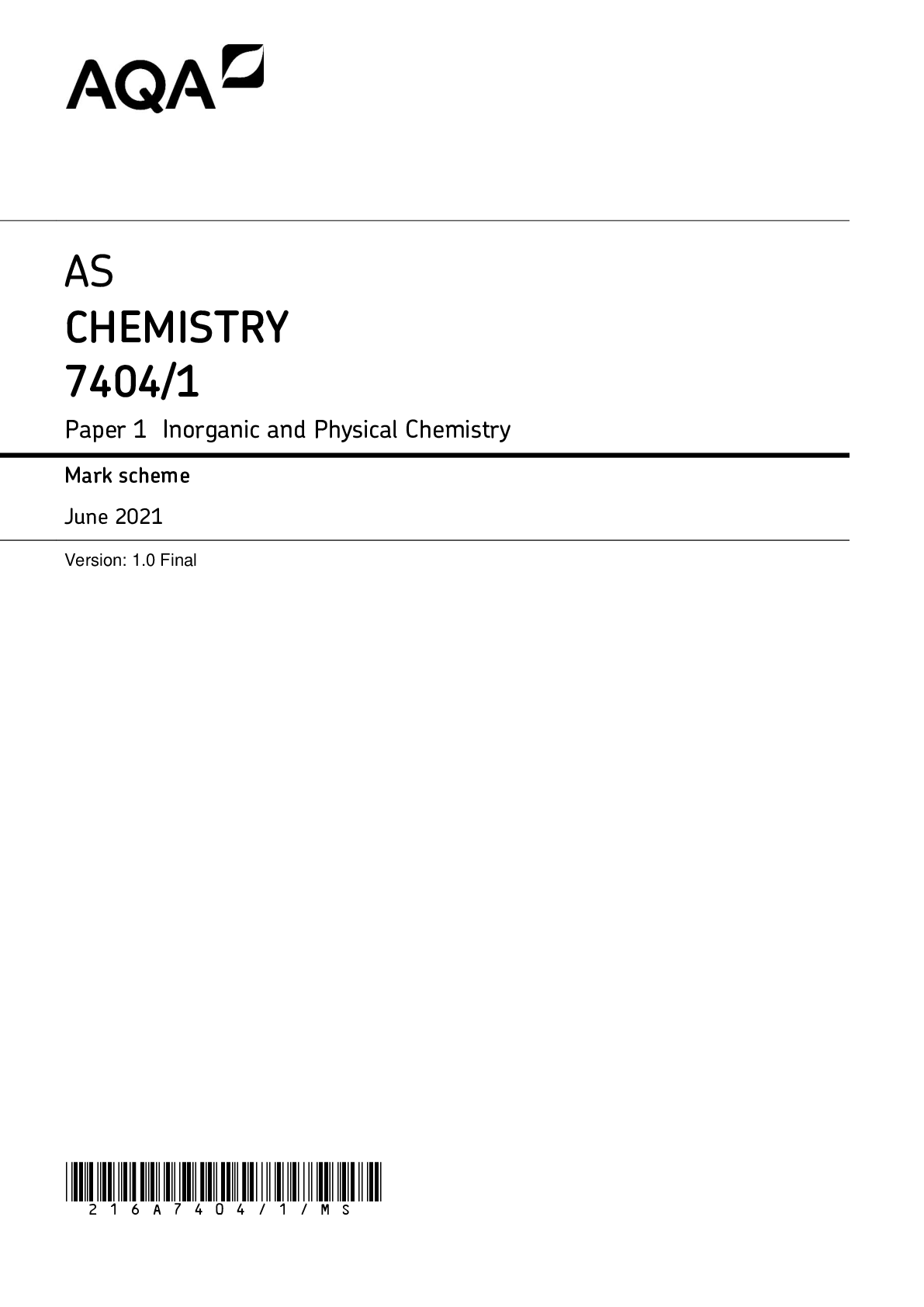
Also available in bundle (2)
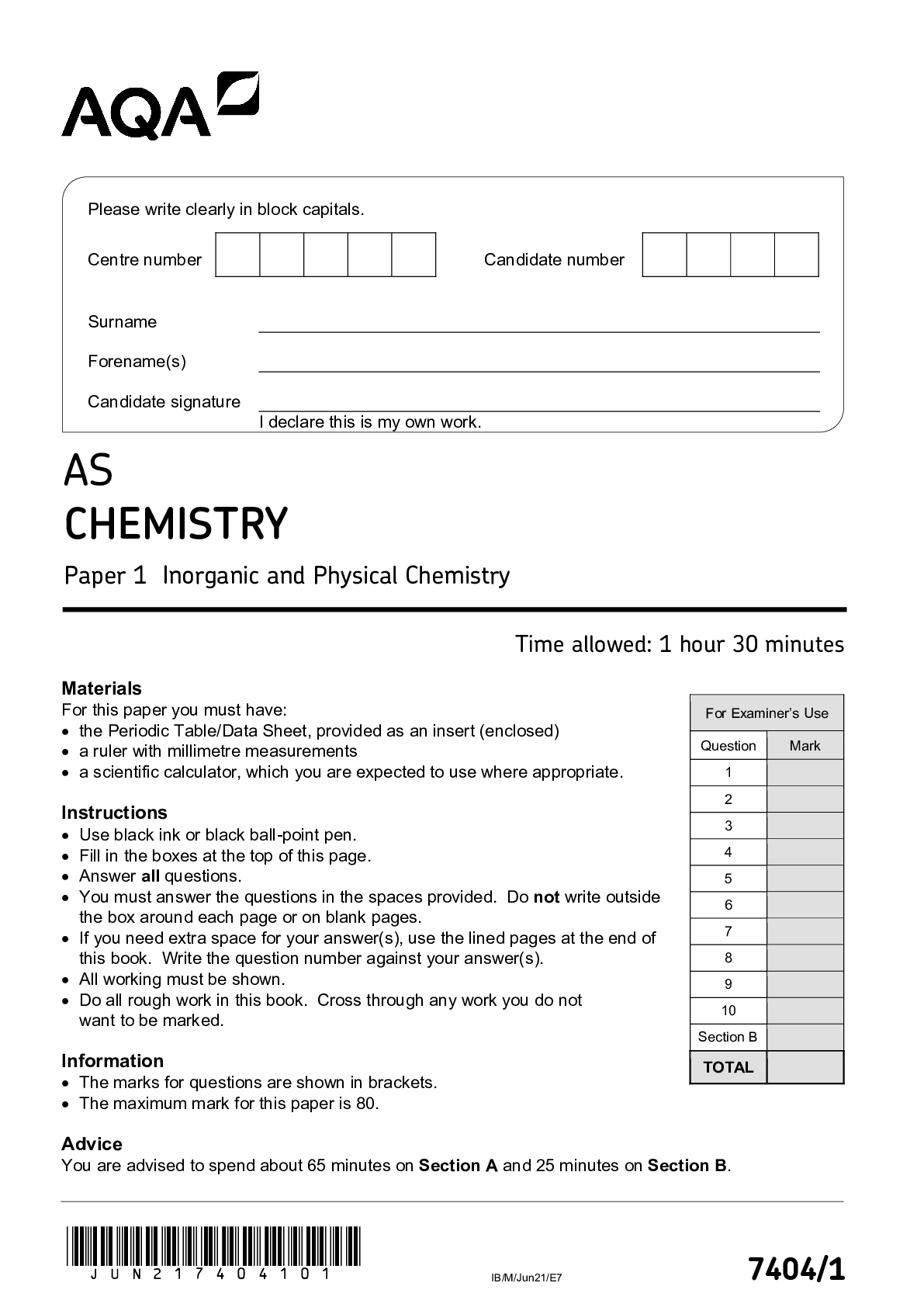
AS Level Chemistry 7401/1 Question Paper & Mark Scheme June 2021 | Inorganic and Physical Chemistry BUNDLE
This Bundle Contains the question paper and verified mark scheme for: AQA AS Level CHEMISTRY 7404/1 Paper 1 Inorganic and Physical Chemistry June 2021 AQA AS Level Chemistry 7404/1 Paper 1 Inorga...
By Tests guru 1 year ago
$10
2

AS Level CHEMISTRY COMPLETE PACKAGE WITH VERIFIED MARK SCHEME
AQA AS Level CHEMISTRY 7404/2 Paper 2 Organic and Physical Chemistry June 2021 | Question Paper AQA AS Level CHEMISTRY 7404/2 Paper 2 Organic and Physical Chemistry Mark Scheme June 2021 AQA AS...
By Tests guru 1 year ago
$17
4
Reviews( 0 )
Document information
Connected school, study & course
About the document
Uploaded On
Jul 06, 2022
Number of pages
23
Written in
Additional information
This document has been written for:
Uploaded
Jul 06, 2022
Downloads
0
Views
28

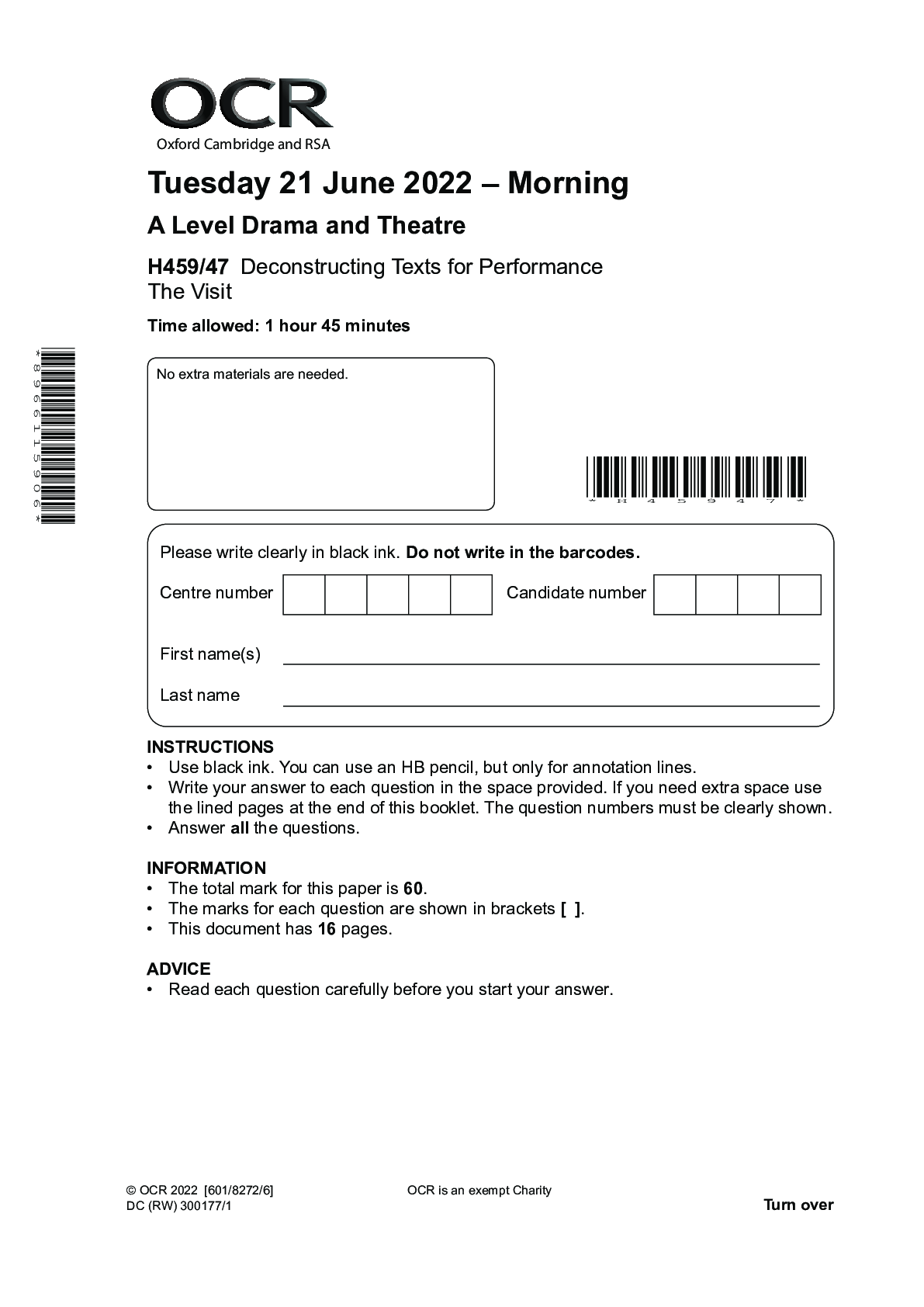
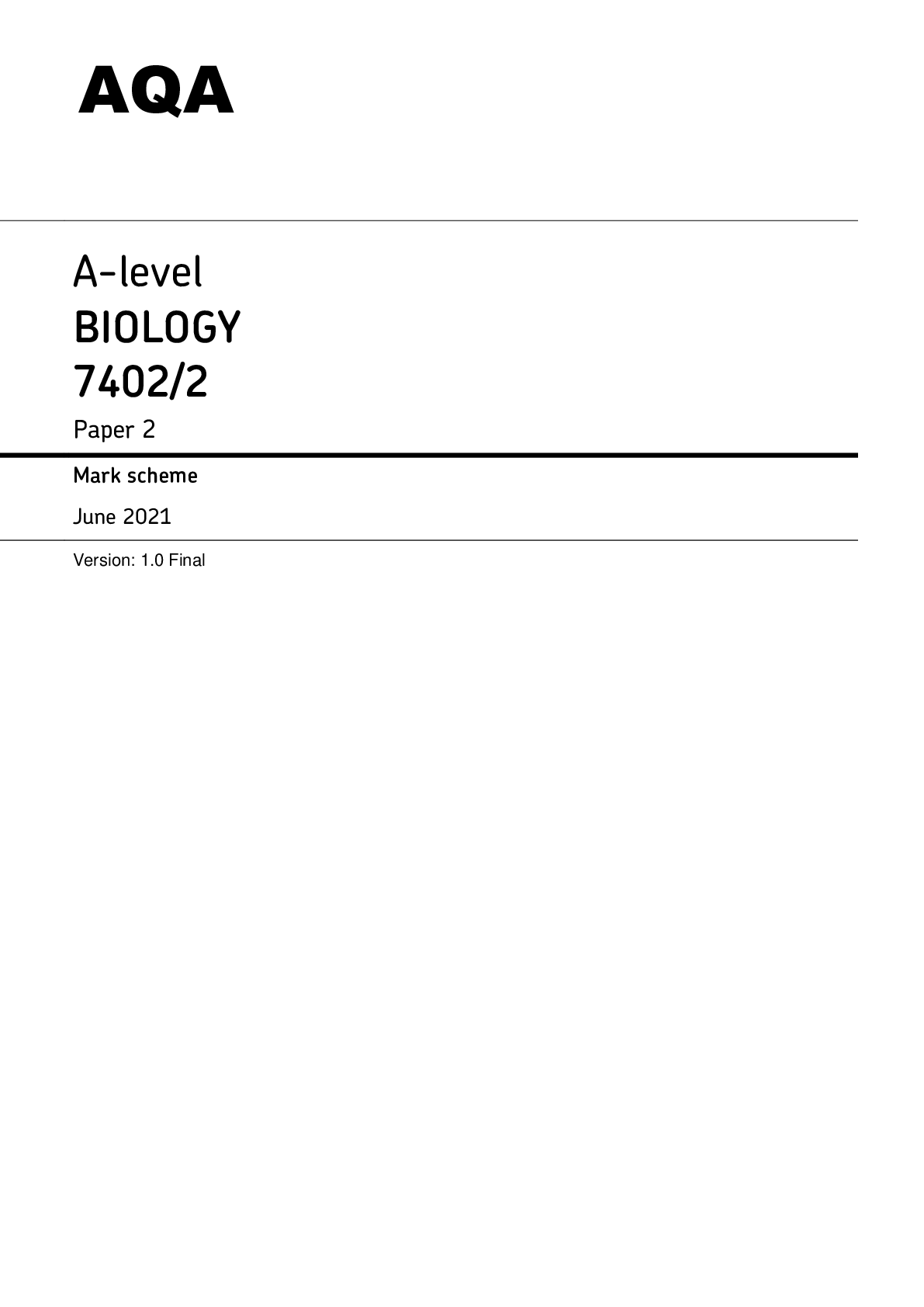
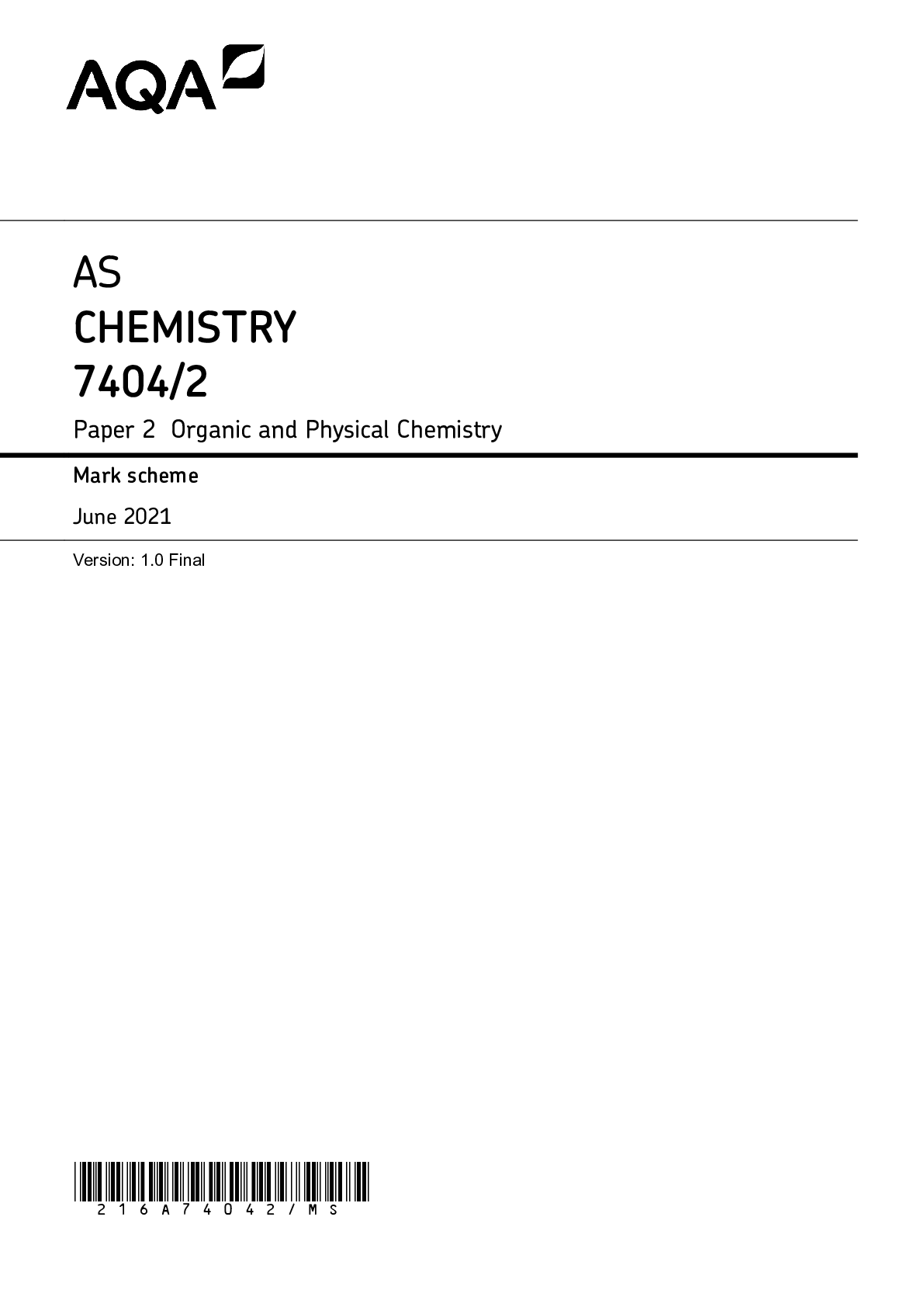



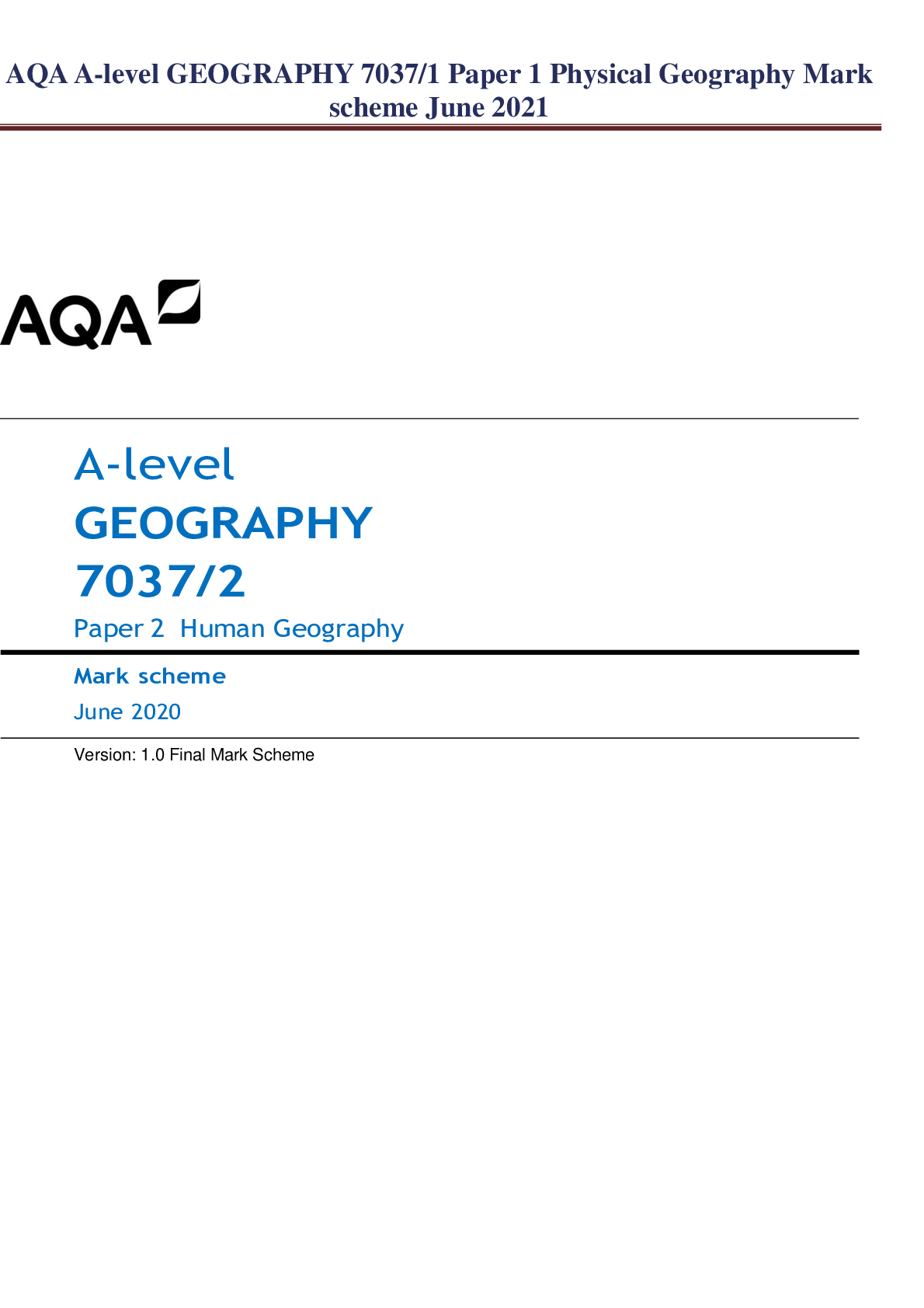

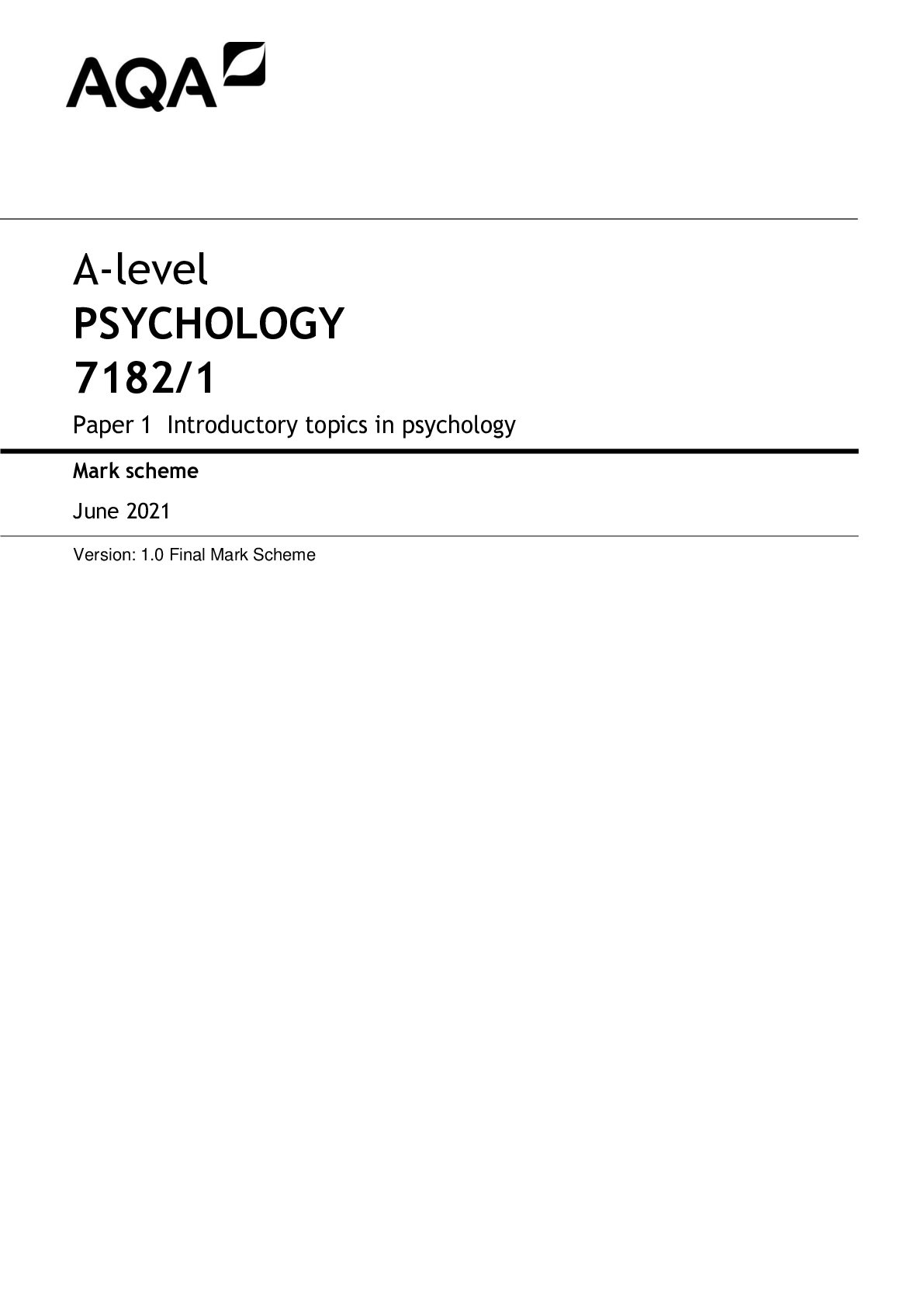

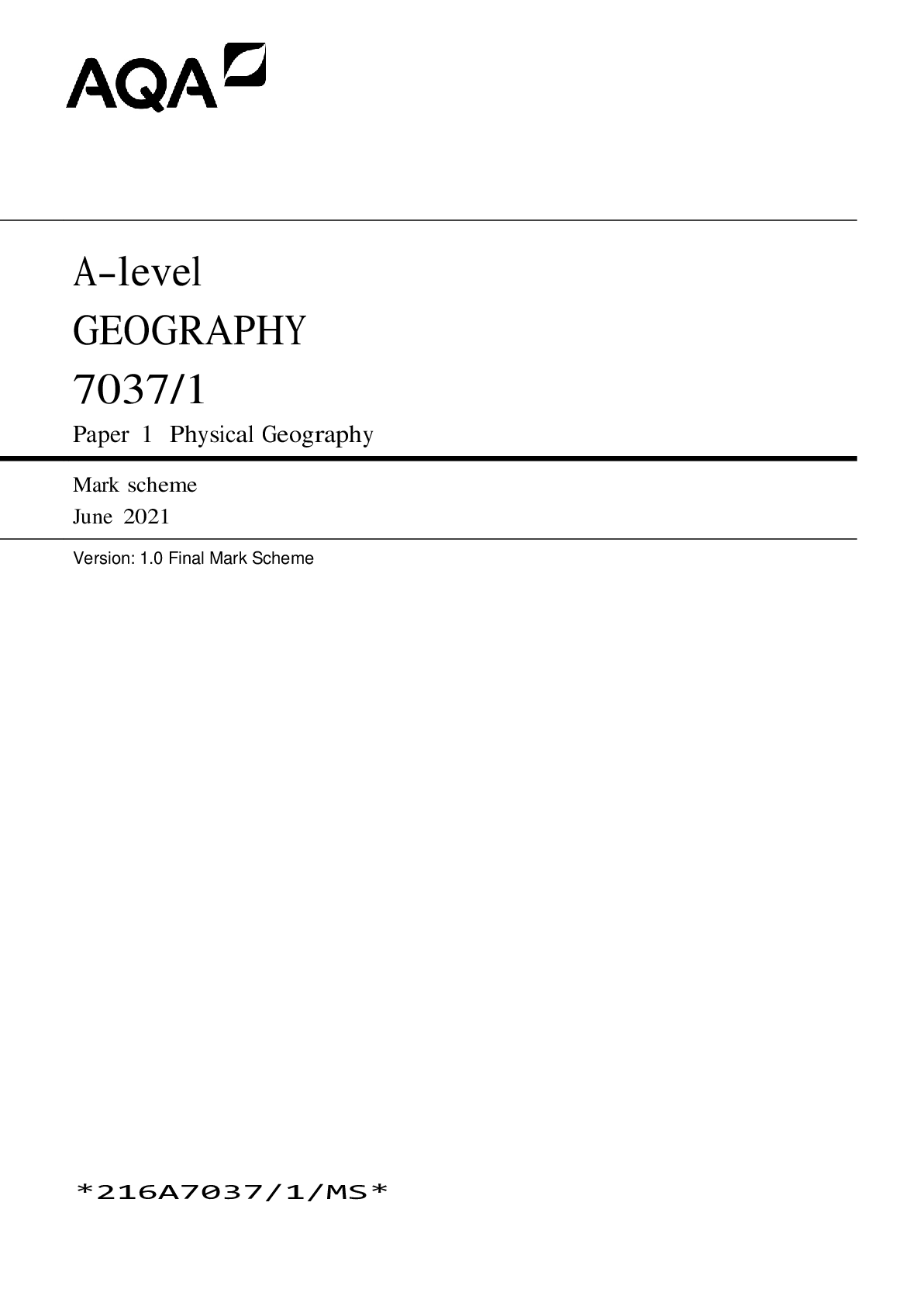

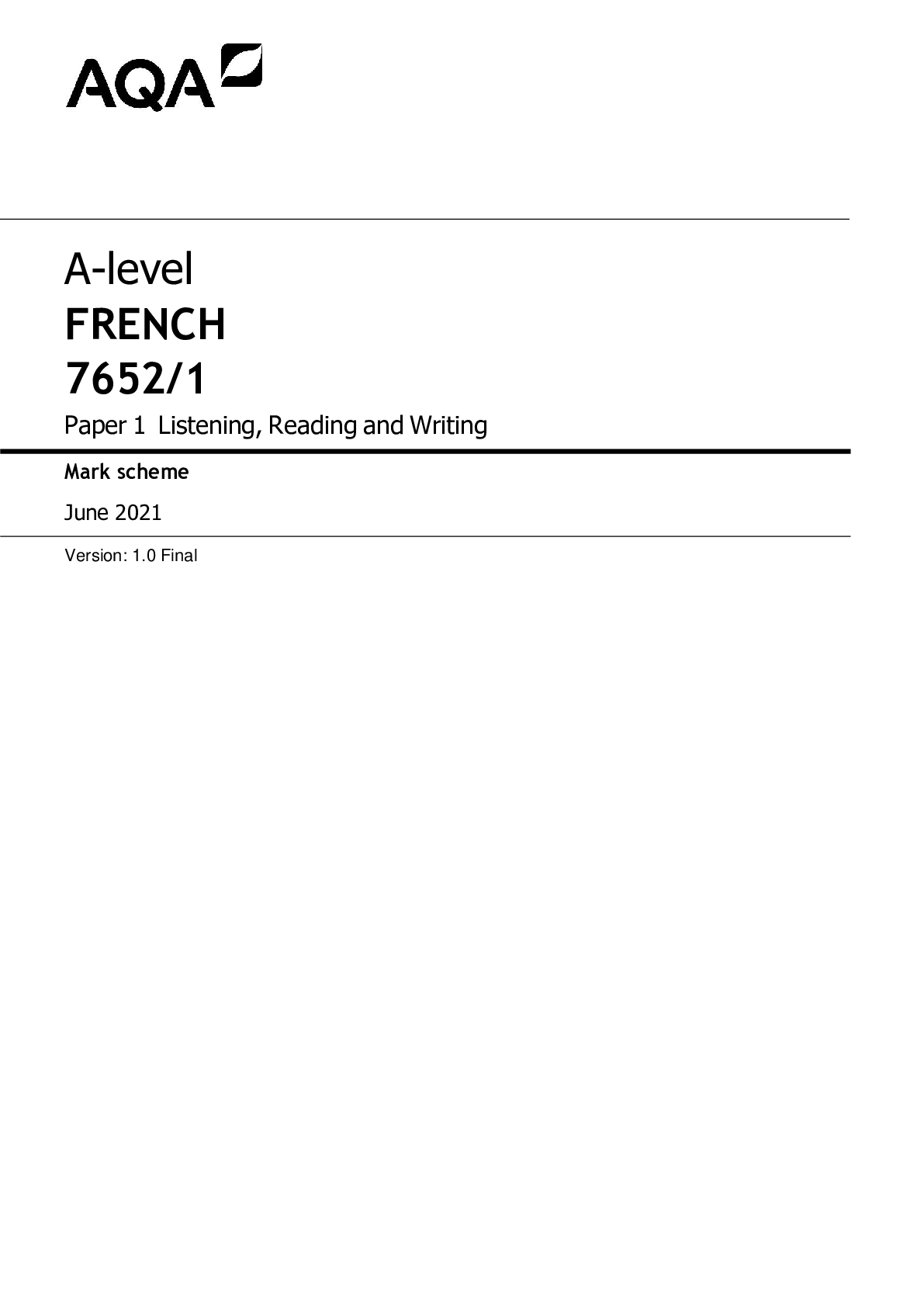
.png)
